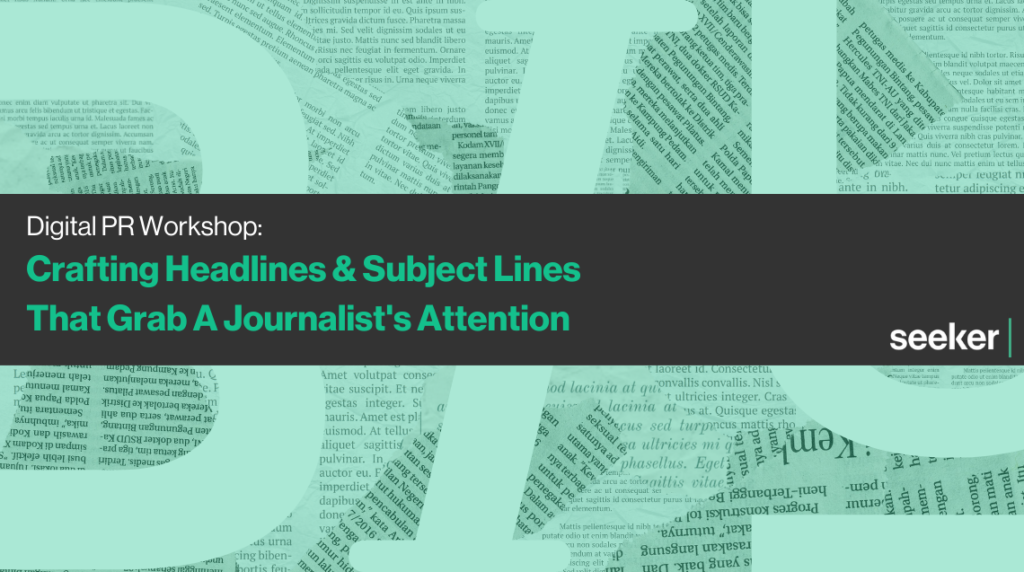
Killer headlines & subject lines are a Digital PR’s ace in the hole, helping your press release stand out against a backdrop of unopened emails. Here’s how to grab the attention of a time-poor journalist.
As Digital PRs we never really know for certain that our story will resonate with a journalist, or even that our story reaches them at the precise opportune moment. We create our targetted media lists, ensure our contacts are on the relevant beat, and craft an awesome pitch all for our press release to fall at the first hurdle: unopened, lost to the ocean that is a journos’ inbox.
Headlines and subject lines are the attention-grabbing statements that give a journalist reason to read our press release in the first place. To hit home, our chosen headlines and subject lines must summarise our story and establish our news angle.
Scrolling through this article, you’ll find the tips, tricks, and writing prompts I’ve picked up during my first year as a Digital PR. All of which are in the name of getting a journalist to open our press releases and cover our stories. Personally, I like to imagine J. Jonah Jameson as he springs into action at the latest sighting of Spiderman (iconic moustache and all).
Headlines Vs subject lines – What’s the big difference?
What’s the difference between a headline and a subject line? Until sitting down to write this article, I rarely settled on a definitive answer. And to be honest, it’s a nuance that stumped me when writing my first press releases. Now with a few campaigns under my belt, here are the definitions I’ve landed with:
- Headlines: The purpose of a headline is to quickly grab a reader’s attention and highlight key story angles. It should clearly communicate what the story is about and, where possible, mimic or match the headline convention of your target publication. These are written for wide appeal and to establish a story hook.
- Subject line: The subject line is your first point of contact with a journalist – it comes before any headlines and packages your entire press release into a sentence in someone’s inbox. You want to concisely summarise what’s being offered with the aim of being accurate and increasing the open rate of your press release. The more eyes on your press release, the more likely it is you’ll pick up coverage.
The key differences between a headline and a subject line boil down to the audience and the purpose. Subject lines are written for a single journalist looking to write a story; headlines are aimed toward the audience who read the publication a journalist writes for.
What do journalists look for in a headline?
Nowadays, many publications judge successful articles on the total clicks and engagement they receive. This, of course, typically begins with an eye-catching headline – which is a point made all the more poignant by Science Post in 2016.
Conducting a social experiment of sorts, the satirical news publication wrote an article titled “70% of Facebook users only read the headline of science stories before commenting”. The article was devoid of content and solely written in Lorem Ipsum. 46,000 people shared the story, some of them “quite earnestly” reported The Washington Post.
For the above reason, the headlines we write should be clear, impactful and tell the truth in an interesting way. For me, the best headlines are concise and rich in information. Plus, in today’s world – which again is one where only 2 in 10 read beyond the headline – it’s also essential headlines can be understood out of context. This is equally important considering headlines often appear without the corresponding article in SERPs (search engine result pages).
Tips for writing the perfect headline
Journalists are time-poor and they often base their decisions on headlines and intro text. As PRs, we need to get our story across effectively using as few words as possible.
When creating headlines for our campaigns, I follow these rules:
- Keep it tight: No more than 10-12 words is a good point of reference
- Stick to the point: Summarise your main point or angle
- Attract attention: Use interesting and active words
- Don’t be over the top: Journalists want facts, not hyperbole
- Avoid writing a blog title: Imagine your headline in a newspaper article
- Match the tone of your press release: Be consistent with your writing style
- Don’t put your brand in the headline: It doesn’t improve the story, it looks like an ad
By following these rules you set up a solid and repeatable framework for every campaign.
When creating press releases, also write in a journalistic style and with journalists in mind. Often we see headlines repurposed in our coverage, so there is a lot of value in picturing headlines as front-page news when writing them.
Tailoring headlines to specific publications
A glance at today’s Google News or your spotlessly curated Feedly account soon shows that most news outlets take a very different approach to reporting on the same story. So, personalisation matters when it comes to outreaching our campaigns.
Every publication has a specific style or framework for headline writing. Sometimes the difference is stark; other times the variable is ever so slight, totally minute. Regardless, seemingly insignificant quirks like knowing if a publication writes numbers numerically or not make a bigger difference than you may imagine. As such, we should emulate these conventions to show we understand and know the publication we’re pitching to.
Once you have a handful of potential headlines, make a list of publications you would like or expect to cover your story. Take time to study these publications and consider how they format headlines. Now reframe your headline options in the same style. Imitation is the sincerest form of flattery, after all.
Top tip: Ensure you’re always reading a range of different publications. Get to know these outlets, what they report on, and their common headline formats. Reading just one or a small number of select publications limits your headline options – variety gives press releases the best chance of coverage!
TACT test your headlines
Digital PRs have a responsibility to the clients and brands we represent. TACT testing headlines – an idea lifted from Columbia University – is a stellar safety net for ensuring headlines remain accurate and truthful, as well as interesting.
TACT stands for taste, attractiveness, clarity and truth.
- Taste: Is it in good taste? Can your headline be interpreted in a negative way?
- Attractiveness: Does your headline attract attention while remaining accurate?
- Clarity: Are there any odd words or double meanings? Does it communicate clearly?
- Truth: Is your angle truthful to the story and the research you’ve conducted?
Benchmark your headline options against the TACT test. If your headline fails any of the questions, reject them. It’s vitally important to always consider how a headline might be viewed in the public eye and how a journalist could represent your story.
Using emotive language and sensory words in headlines
Emotive language (or trigger words) is one of the most common tactics used by PRs to gain attention in today’s news cycle. Look to add these to your headlines where appropriate.
I recommend creating an emotive word bank, a cluster of wonderful trigger words to weave in and out of your campaign headlines. It can often help to have these words on hand for inspiration. Copyblogger and CoSchedule have rather extensive blogs on this subject. Still, simple words like “revealed” and “new” tend to be staples in my press releases as they illustrate a solution to a problem and demonstrate a sense of urgency.
Don’t inflate your headlines, however, and risk presenting your story as inaccurate or clickbaity. Err on the side of caution when using hyperbole to get your point across.
Ask yourself: Am I exaggerating to get attention? Am I deceiving the journalist and their audience? Perhaps setting the reader’s expectations too high? When in doubt, think back to the TACT test and whether you would use these words in conversation.
Writing subject lines that boost the open rate
The subject lines’ job is to make a journalist open our email. Journalists don’t want to work stuff out. The subject line is our opportunity to serve a press release on a platter, so say exactly what it says on the tin!
Include phrases that describe what we’re offering. Classic examples include:
- ‘Story idea’
- ‘Story suggestion’
- ‘Interesting travel trend’
- ‘New survey’
- ‘Expert comment available’
- ‘TikTok Data’
- ‘New data’
- ‘Research reveals’
It’s important to be clear, not clever when writing subject lines. Keeping your subject line simple and direct delivers the news efficiently and means you don’t mislead the journalist. Don’t overthink the word count either. Typically you have fewer words to play with than a headline, but ten words are average and I’d extend to twelve.
Headlines and subject lines are powerful for digital PR, but there’s an art to getting them right and ensuring they strike the correct tone while remaining attention-grabbing. Perfecting this skill is all about practising and training your brain to think like a journalist.
Find below an example of a writing prompt we use at Seeker to get our brains in headline-writing mode. Use it to create a list of attention-grabbing headlines of your own!
Writing prompt: Five headlines in five minutes ⏰
Think of a campaign you’re working on right now or an interesting news story you’ve come across today. Write five attention-grabbing headlines for it in five minutes or under, focusing on the information contained in this article. Don’t worry if you can’t get to five headlines – this prompt is all about getting your brain in gear!
| # | Headline options |
| 1 | |
| 2 | |
| 3 | |
| 4 | |
| 5 |
